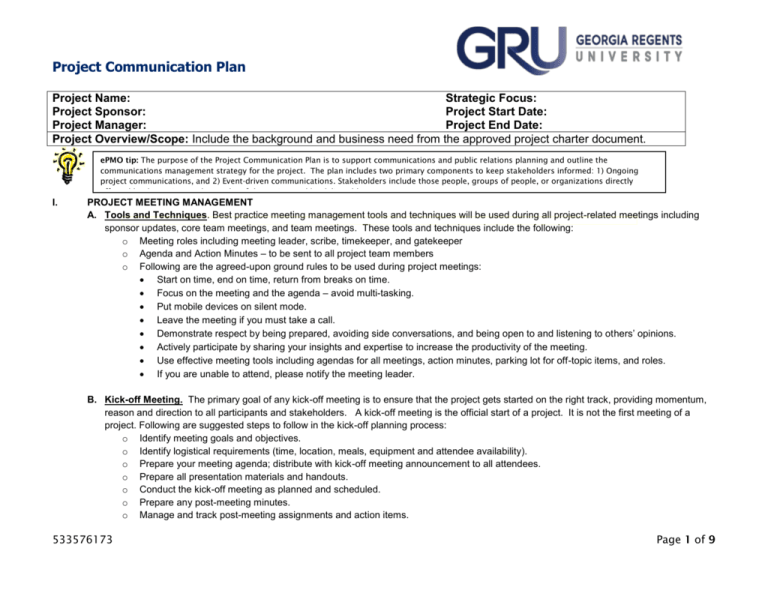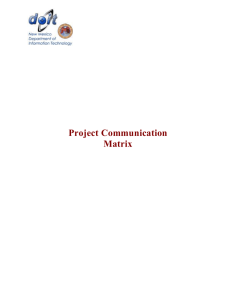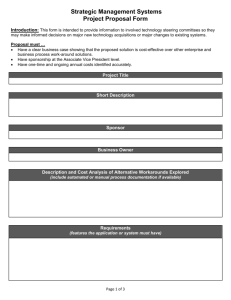Project Communication Plan
advertisement

Project Communication Plan Project Name: Strategic Focus: Project Sponsor: Project Start Date: Project Manager: Project End Date: Project Overview/Scope: Include the background and business need from the approved project charter document. ePMO tip: The purpose of the Project Communication Plan is to support communications and public relations planning and outline the communications management strategy for the project. The plan includes two primary components to keep stakeholders informed: 1) Ongoing project communications, and 2) Event-driven communications. Stakeholders include those people, groups of people, or organizations directly affected by the project or the results of the project and/or deliverables. I. PROJECT MEETING MANAGEMENT A. Tools and Techniques. Best practice meeting management tools and techniques will be used during all project-related meetings including sponsor updates, core team meetings, and team meetings. These tools and techniques include the following: o Meeting roles including meeting leader, scribe, timekeeper, and gatekeeper o Agenda and Action Minutes – to be sent to all project team members o Following are the agreed-upon ground rules to be used during project meetings: Start on time, end on time, return from breaks on time. Focus on the meeting and the agenda – avoid multi-tasking. Put mobile devices on silent mode. Leave the meeting if you must take a call. Demonstrate respect by being prepared, avoiding side conversations, and being open to and listening to others’ opinions. Actively participate by sharing your insights and expertise to increase the productivity of the meeting. Use effective meeting tools including agendas for all meetings, action minutes, parking lot for off-topic items, and roles. If you are unable to attend, please notify the meeting leader. B. Kick-off Meeting. The primary goal of any kick-off meeting is to ensure that the project gets started on the right track, providing momentum, reason and direction to all participants and stakeholders. A kick-off meeting is the official start of a project. It is not the first meeting of a project. Following are suggested steps to follow in the kick-off planning process: o Identify meeting goals and objectives. o Identify logistical requirements (time, location, meals, equipment and attendee availability). o Prepare your meeting agenda; distribute with kick-off meeting announcement to all attendees. o Prepare all presentation materials and handouts. o Conduct the kick-off meeting as planned and scheduled. o Prepare any post-meeting minutes. o Manage and track post-meeting assignments and action items. 533576173 Page 1 of 9 Project Communication Plan o Conduct a post-meeting assessment. C. Communication Plan Development Process (flowchart) Communications Plan Development & Implementation Process Project Sponsor & Director No Changes Project Kick-off Meeting Gather Planning Inputs Project Manager Sponsor/Director Review & Input Includes Project Charter, Critical Issues Results, Etc. Prepare First Draft Communications Plan Changes Include communication plan tasks in the Project Schedule Incorporate Changes & Finalize Project Communications Plan Using Communication Plan Template, Identify Stakeholders Interview Stakeholders, if needed Conduct Stakeholder Analysis Determine Stakeholder Needs/Desired Outcomes Changes Core Team Identify Communication Methods and Responsibilities 533576173 Review & Provide Input Implement Communications Plan Page 2 of 9 Project Communication Plan ePMO tip: Five easy steps : 1) define your audience/stakeholders, including subsets or segments;, 2) identify your social relationship with them; 3) understand the context and frames of reference of your relationship; 4) develop your message effectively; 5) choose the proper vehicle/method to convey your message. II. PROJECT COMMUNICATIONS - Ongoing A. Identify Project Stakeholders (Stakeholder Register-include inputs/outputs) Purpose: Identify critical stakeholders for the project. Who are the people or groups of people who are impacted by or will be impacted by the project and its implementation? Consider both internal and external stakeholders and groups. Who needs to know? Who has a right to know? Who wants to know? (Stakeholder types: internal, external, supporter, neutral, resistor) # Stakeholder Type Stakeholder Names/Groups – Interest/Role/Location B. Identify Potential/Existing Communication Methods/Vehicles (What, how, when) Purpose: Once the stakeholders have been identified, complete the following chart to identify currently existing methods and/or vehicles to communicate to the stakeholders, as well as brainstorm potential methods and/or vehicles. Existing Communication Methods/Vehicles 533576173 Potential Communication Methods/Vehicles Page 3 of 9 Project Communication Plan C. Develop Routine and Ongoing Project Communications Purpose: Project implementation offers regular opportunities for communications to key stakeholders. These communications could include the status of the project, identification of critical issues, resource needs, etc. Use the stakeholder analysis (Table II.D) and the following matrix to develop the routine and ongoing communications plan for the project. This plan should be reviewed at least once per month during Core Team meetings. Methods of Communication (what) Project Kick-off Meeting Sponsor (s) Update Meetings Audience/Stakeholder (who) Sponsor, Project Leaders, Project Manager, Project Team Members, Identified Stakeholders Sponsor (s), Project Leaders, Project Manager Advisory Committee Meetings Core Team Meetings Advisory Team Members, Project Leaders, Project Manager Core Team Members Core Team Meeting Agendas & Action Minutes Core Team Members Status Reports All Project Team Members, including Sponsor Team Meetings Team Leaders and Team Members Team Meeting Agendas & Cumulative Action Minutes Project Documentation Repository Core Team, Team Leaders, and Team Members Issues Log All Project Team Members Risk Log All Project Team Members Decisions Log All Project Team Members Communication Activity Log All Project Team Members 533576173 All Project Team Members Purpose (why) Engage key stakeholders in identifying critical issues (major tasks, assumptions, risks, and questions to be answered). Provide regular updates on the project status, discuss issues, make decisions, and gain support as needed. Provide high-level update on project status and gain input from team members on the project. Review status, issues, communications, and risks. Plan core team meetings in advance and allow participants to prepare and to track actions and decisions from each meeting. Provide written status update on activities completed, upcoming activities, milestones, issues, and risks. Manage the day-to-day aspects of the project based on the specific functional or technical area and team charge. Plan for and document the actions and decisions from the individual team meetings. The project documents for this project are located in the shared drive under IE folder/EPMO/@EPMO projects/project name Log identified issues, status, responsible party, and resolution. Log identified risks, preventive plans, mitigations plans, and triggers for mitigation implementation. Log decisions reached during all meetings – core team, individual teams, sponsor’s update, etc. Log record of communication activity and checklist for project communications. Frequency/ Date (when) One time at beginning of project Responsibility (by whom) Project Manager Project Manager Monthly As needed Project Manager Bi-weekly or as needed Bi-weekly or as needed Project Manager Bi-weekly Project Manager Weekly or as needed Team Leaders Weekly or as needed Ongoing Team Leaders Ongoing Project Manager Ongoing Project Manager Ongoing Project Manager Ongoing Project Manager Project Manager Project Manager Page 4 of 9 Project Communication Plan D. Complete Stakeholder Analysis (Table to include steps 1 & 2) Purpose: Once the stakeholders have been identified, complete the following chart to analyze their needs and possible alternatives for communications. Sensitivities/Needs Audience/Stakeholder (Stakeholder interest in project) Expected Result What We Need/Expected Result of Communications Possible Vehicle(s) & Methods of Communication Frequency Source Delivered by(date) E. Create Communication Activity Log (Table includes, dates, audience, types of communication) Purpose: The communication activity log provides an ongoing record and checklist for the project communications. This document should be kept up-to-date by the project manager and reviewed regularly at Core Team Meetings. This activity log should include a view of four to six weeks out into the future. Date 533576173 Status Vehicle(s) & Methods of Communication Responsibility Page 5 of 9 Project Communication Plan 533576173 Page 6 of 9 Project Communication Plan III. CHANGE MANAGEMENT ePMO tip: If the project scope identifies that employees will do their job differently, a change management plan is required. If so, contact Pam Witter, Change Management Specialist at 1-9269. A. Develop Change Management Communication Plan/Messaging Purpose: The change management communication plan is designed to support change management project during the ‘change’ process and is targeted primarily for internal audiences/stakeholders. The communications strategy is to develop message content for each audience and send during the six stages of the change management project as listed below. Audience: List table for each audience ((executive, mid-managers, employees, customers, and suppliers) Frequency First indications of change Message Content Vehicle(s) & Methods of Communication Responsibility Delivery Date Early stages of the project During the design of the change Before implementation During implementation Post-implementation B. Develop messages outline to address for each audience. Messages about the business today (current situation and the rationale for change; competitive, customer, and financial issues) Messages about the change (vision, scope, objective, alignment of change with business strategy, details about the solution) Messages about how the change impacts employees (“what’s in it for me”; procedures for help and assistance) Status updates and progress reports (schedule, key decision points, major milestones and deliverables) 533576173 Page 7 of 9 Project Communication Plan IV. PROJECT COMMUNICATIONS –Event-driven/One Time A. Determine Opportunities for Event-driven or One-time (tied to major milestones) Purpose: During the life of the project, opportunities will arise for one-time or event-driven communications. Identify the opportunities that are known by completing the following matrix. This matrix should be reviewed every two months to take advantage of communications opportunities. Project Milestones What are the major project milestones requiring communications or providing communications opportunities? One-time Communication Opportunities What opportunities exist to provide communications? Meetings? Events? B. Develop General Messages & Topic Glossary Purpose: Once the stakeholders have been identified and analyzed, develop a list of the key message points that should be used for consistent communication across all stakeholder groups. Develop a topic glossary that will provide consistent answers to the basic questions about the project. Messages: The Banner we start with will not be the Banner we end up with. Impact of Banner is a fundamental shift in the way we do business. Topic Description C. Develop Communication Plan for Event-driven or One-time Communications 533576173 Page 8 of 9 Project Communication Plan Purpose: Once the project milestones and potential communication opportunities are identified, develop the working communication plan for event-driven or one-time communications. This plan should include communications for at least the next six months. Event-driven/One-Time Communications Plan – 6-Month Planning Delivery Date Vehicle(s) & Methods of Communication Audience/ Stakeholder Message Responsibility Resource $$ Month 1 Month 2 Month 3 Month 4 Month 5 Month 6 533576173 Page 9 of 9








